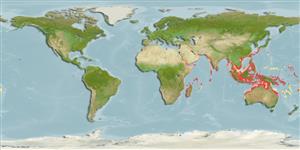Common names from other countries
Environment: milieu / climate zone / depth range / distribution range
Ecología
marino; agua dulce; salobre demersal; pH range: 7.0 - 8.0; dH range: 9 - 19; anfidromo (Ref. 51243). Tropical; 22°C - 28°C (Ref. 2060)
IIndo-Pacific: from Reunion I., India, and Bangladesh to the Philippines, Indonesia, Thailand, Vietnam, Cambodia, Papua New Guinea, Australia and the Solomon Is.
Tamaño / Peso / Age
Maturity: Lm ? range ? - ? cm
Max length : 15.0 cm TL macho / no sexado; (Ref. 6802); peso máximo publicado: 18.95 g (Ref. 124712)
Espinas dorsales (total) : 7; Radios blandos dorsales (total) : 8; Espinas anales: 1; Radios blandos anales: 8 - 9. Dark longitudinal lines on body; caudal fin black with light margin dorsally; pectoral base with 1-2 black spots (Ref. 5493).
Inhabits brackish mangrove estuaries and lower reaches of freshwater streams, usually on mud bottoms (Ref. 44894). Usually found in lagoons and estuaries, particularly where there is vegetation (Ref. 6028, 79840). Occurs frequently in mangrove swamps (Ref. 2847, 79840). Occasionally ascends rivers (Ref. 6028). Feeds mainly on small fishes and crustaceans (Ref. 6028, 79840). Marketed fresh (Ref. 12693).
Life cycle and mating behavior
Maturities | Reproducción | Spawnings | Egg(s) | Fecundities | Larva
Keith, P. and M.I. Mennesson, 2023. Review of Butis (Teleostei: Butidae) from Indo-Pacific islands with description of three new species. Cybium 47(4):431-466. (Ref. 130228)
IUCN Red List Status (Ref. 130435)
CITES (Ref. 128078)
Not Evaluated
Threat to humans
Harmless
Human uses
Pesquerías: escaso valor comercial
Herramientas
Special reports
Download XML
Fuentes de Internet
Estimates based on models
Preferred temperature (Ref.
115969): 24.7 - 29.1, mean 28.2 (based on 1196 cells).
Phylogenetic diversity index (Ref.
82804): PD
50 = 0.5156 [Uniqueness, from 0.5 = low to 2.0 = high].
Bayesian length-weight: a=0.00575 (0.00231 - 0.01432), b=3.07 (2.85 - 3.29), in cm Total Length, based on LWR estimates for this (Sub)family-body shape (Ref.
93245).
Nivel trófico (Ref.
69278): 4.0 ±0.66 se; based on food items.
Resiliencia (Ref.
120179): Alto, población duplicada en un tiempo mínimo inferior a 15 meses (Preliminary K or Fecundity.).
Fishing Vulnerability (Ref.
59153): Low vulnerability (10 of 100).
